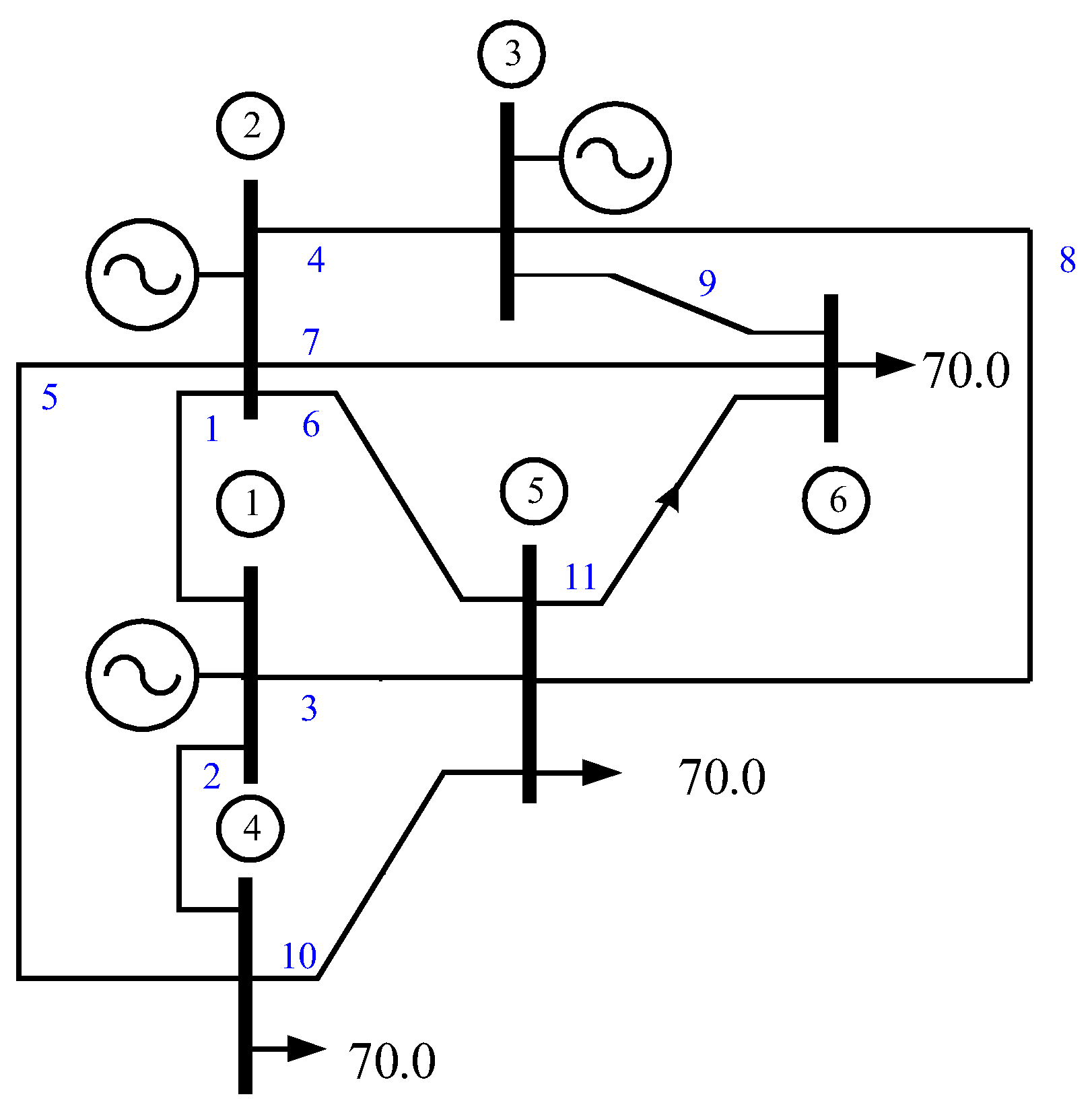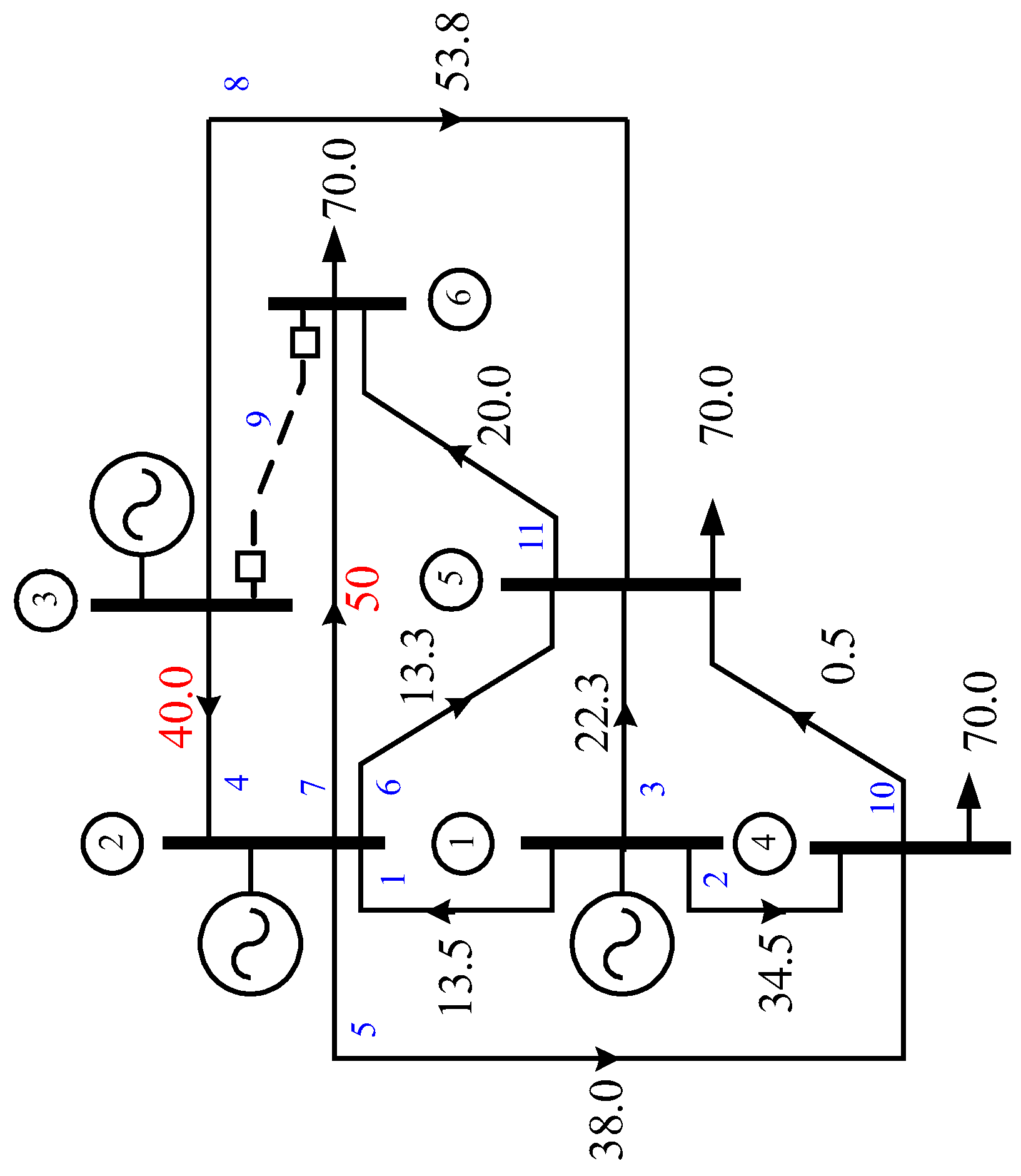Preventive Security-Constrained DCOPF Formulation Using Power Transmission Distribution Factors and Line Outage Distribution Factors
Abstract
:1. Introduction
1.1. DCOPF Literature Review
- (i)
- In the first OPF problem, the mathematical formulation includes only the control variables that are feasible simultaneously for both the pre- and the post-contingency constraints. For this analysis, the optimization problem (variables and constraints) is larger than the traditional OPF because the post-contingency constraints are included in the problem. Furthermore, modelling several outages for large-scale power systems is a demanding and time-consuming issue in the SCOPF problem [7,8].
- (ii)
- On the other hand, the corrective OPF problem is because some overload conditions caused by the contingency can occur in the power system without affecting the safety in the power components. Notice that the ISO has a short time to take actions in the post-contingency control variables to accomplish a safe operational state; for instance, re-dispatching the power unit generation and moving the transformer taps. For this mathematical formulation, it is necessary to include more decision variables and constraints. Therefore, it would need a large number of actions for modelling a selected number of contingencies [4,9,10,11].
1.2. Transmission Network Modelling
1.3. Contributions
2. Classical DC-Based Optimal Power Flow
- (i)
- High voltage transmission lines can be considered lossless; that is, the line resistance can be disregarded;
- (ii)
- The voltage angle differences in a transmission element are very small, and
- (iii)
- The voltage magnitudes for each electrical bus are close to the nominal voltage. Based on this consideration, it is possible to eliminate the Q vs. V relationship. Therefore, the reactive power is eliminated as a variable in the transmission network modelling.
2.1. DCOPF Formulation Using PTDF
2.2. SC-OPF Formulation Using PTDF and LODF
2.2.1. Post-Contingency Handling Constraints
2.2.2. Mathematical Formulation
2.2.3. Interior-Point Algorithm
3. Results
3.1. DCOPF Based on PTDF Factors
- The classic 6-bus power system introduced by Wood and Wollenberg [6] is used to illustrate the OPF using both the classical DC-based and the PTDF-based formulations. In Figure 1, shows the electrical transmission network. The electrical power system contains three generators and eleven transmission lines. The power generation and transmission data can be seen in Reference [6] or in MatPower [24].
- The next simulation considers that two transmission lines are limited: (1) line 2–4 to 40 MW and (2) line 2–6 to 50 MW. The OPF formulation is as follows:
- Different test systems are used to check both formulations applied to the DCOPF problem: 9-bus system (three generators and nine transmission lines); 14-bus system (five generators and twenty transmission lines); 30-bus system (six generators and forty-one transmission lines); 57-bus system (seven generators and eighty transmission lines); and 118-bus system (fifty-four generators and one hundred eighty-six transmission lines). Technical data can be seen in MatPower.
- To determine the performance for each formulation, the authors have decided to program the OPF quadratic formulation using Gurobi. Table 3 shows the performance of simulation times for both formulations considering 100 trials. Additionally, included are the minimum, the maximum and the average simulation time.
3.2. DCOPF Based on PTDF and LODF Factors
- For the 6-bus power system, the worst contingency considers the outage of transmission line 3–6. The SCOPF problem using the PTDF and LODF is introduced as follows:
- Last, in MatPower, there is another power system case called “case13659pegase.m”. This model represents the Polish 400, 220 and 110 kV networks during the winter 1999–2000 peak conditions. In the system, there are 327 generators and 2896 transmission lines.
4. Conclusions
Author Contributions
Acknowledgments
Conflicts of Interest
References
- Carpentier, J. Contribution a L’etude du Dispatching Economique. Bull. Soc. Fr. Electr. 1962, 8, 431–447. [Google Scholar]
- Momoh, J.; Adapa, R.; El-Hawary, M. A review of selected optimal power flow literature to 1993. IEEE Trans. Power Syst. 1993, 14, 96–104. [Google Scholar] [CrossRef]
- Pizano, A.; Fuerte, C.R.; Ruiz, D. A new practical approach to transient stability constrained optimal power flow. IEEE Trans. Power Syst. 2011, 26, 1686–1696. [Google Scholar] [CrossRef]
- Martínez-Lacañina, P.; Martínez-Ramos, J.; de la Villa-Jaén, A. DC corrective optimal power flow base on generator and branch outages modelled as fictitious nodal injections. IET Gener. Transm. Distrib. 2014, 8, 401–409. [Google Scholar]
- Willis, H.L. Power Distribution Planning: Reference Book; Marcel Dekker Inc.: New York, NY, USA, 2004. [Google Scholar]
- Wood, A.J.; Wollenberg, B.F. Power Generation, Operation and Control; John Wiley & Sons: Hoboken, NJ, USA, 1996. [Google Scholar]
- Alsac, O.; Stott, B. Optimal Load Flow with Steady-State Security. IEEE Trans. Power Appar. Syst. 1974, 93, 745–751. [Google Scholar] [CrossRef]
- Wu, X.; Zhou, Z.; Liu, G.; Qi, W.; Xie, Z. Preventive security-constrained optimal power flow considering UPFC control modes. Energies 2017, 10, 1199. [Google Scholar] [CrossRef]
- Monticelli, A.; Pereira, M.V.F.; Granville, S. Security-constrained optimal power flow with post-contingency corrective rescheduling. IEEE Trans. Power Syst. 1987, 2, 175–180. [Google Scholar] [CrossRef]
- Dzung, P.; Kalagnanam, J. Some efficient optimization methods for solving the security-constrained optimal power flow problem. IEEE Trans. Power Syst. 2014, 29, 863–872. [Google Scholar]
- Phan, D.; Sun, X. Minimal impact corrective actions in security-constrained optimal power flow via sparsity regularization. IEEE Trans. Power Syst. 2015, 30, 1947–1956. [Google Scholar] [CrossRef]
- Capitanescu, F.; Martinez-Ramos, J.L.; Panciatici, P.; Kirschen, D.; Marano-Marcolini, A.; Platbrood, P.; Wehenkel, L. State-of-the-art, challenges, and future trends in security constrained optimal power flow. Electr. Power Syst. Res. 2012, 81, 275–285. [Google Scholar] [CrossRef]
- Chávez-Lugo, M.; Fuertes-Esquivel, C.; Cañizares, C.; Gutierrez-Martínez, V. Practical security boundary-constrained DC optimal power flow for electricity markets. IEEE Trans. Power Syst. 2016, 31, 3358–3368. [Google Scholar] [CrossRef]
- Sass, F.; Sennewald, T.; Marten, A.; Westermann, D. Mixed AC high-voltage direct current benchmark test system for security constrained optimal power flow calculation. IET Gener. Transm. Distrib. 2017, 11, 447–455. [Google Scholar] [CrossRef]
- Gonzalez-Longatt, F.; Rueda, J.L. Power Factory Applications for Power System Analysis; Springer: Berlin, Germany, 2014. [Google Scholar]
- Hinojosa, V.H.; Velásquez, J. Improving the mathematical formulation of security-constrained generation capacity expansion planning using power transmission distribution factors and line outage distribution factors. Electr. Power Syst. Res. 2016, 140, 391–400. [Google Scholar] [CrossRef]
- Fotuhi-Firuzabad, M.; Billinton, R.; Khan, M.E. Extending unit commitment health analysis to include transmission considerations. Electr. Power Syst. Res. 1999, 50, 35–42. [Google Scholar] [CrossRef]
- Biskas, P.N.; Bakirtzis, A.G.; Macheras, N.I.; Pasialis, N.K. A decentralized implementation of DC optimal power flow on a network computers. IEEE Trans. Power Syst. 2005, 20, 25–33. [Google Scholar] [CrossRef]
- Ardakani, A.J.; Bouffard, F. Identification of umbrella constraints in dc-based security-constrained optimal power flow. IEEE Trans. Power Syst. 2013, 28, 3924–3934. [Google Scholar] [CrossRef]
- Kalantari, A.; Restrepo, J.F.; Galiana, F.D. Security-constrained unit commitment with uncertain wind generation: The loadability set approach. IEEE Trans. Power Syst. 2013, 28, 1787–1796. [Google Scholar] [CrossRef]
- Dehghan, S.; Amjady, N.; Kazemi, A. Two-stage robust generation expansion planning: A mixed integer linear programming model. IEEE Trans. Power Syst. 2014, 29, 584–597. [Google Scholar] [CrossRef]
- Hesamzadeh, M.R.; Yazdani, M. Transmission capacity expansion in imperfectly competitive power markets. IEEE Trans. Power Syst. 2014, 29, 62–71. [Google Scholar] [CrossRef]
- Karmankar, N. A new polynomial-time algorithm for linear programming. Combinatorica 1984, 4, 373–395. [Google Scholar] [CrossRef]
- Matpower. Available online: http://www.pserc.cornell.edu/matpower (accessed on 19 May 2018).
- Zimmerman, R.D.; Murillo-Sanchez, C.E.; Thomas, R.J. MATPOWER: Steady-state operations, planning, and analysis tools for power systems research and education. IEEE Trans. Power Syst. 2011, 26, 12–19. [Google Scholar] [CrossRef]
- Matlab. Available online: http://www.matlab.com (accessed on 19 May 2018).
- Gurobi Optimization. Available online: http://www.gurobi.com (accessed on 19 May 2018).


| Description | Value |
|---|---|
| Feasibility condition | 0.00 |
| Gradient condition | 1.37 × 10−16 |
| Complementary condition | 2.86 ×10−7 |
| Cost condition | 3.82 × 10−10 |
| System | Number of Iterations | Cost, $/h |
|---|---|---|
| 9-bus | 14 | 20,393.15 |
| 14-bus | 11 | 7642.59 |
| 30-bus | 10 | 960.09 |
| 57-bus | 10 | 41,006.74 |
| 118-bus | 11 | 125,954.42 |
| Power | Classical Formulation | PTDF Formulation | Improving | ||||
|---|---|---|---|---|---|---|---|
| System | Min, ms | Max, ms | Average, ms | Min, ms | Max, ms | Average, ms | % |
| 9-bus | 0.9784 | 1.3668 | 1.0851 | 0.7898 | 1.1708 | 0.9211 | 3.74 |
| 14-bus | 0.9993 | 1.4488 | 1.1281 | 0.7687 | 1.1779 | 0.8968 | 5.22 |
| 30-bus | 2.1078 | 2.4357 | 2.2149 | 0.9460 | 1.4597 | 1.1152 | 19.94 |
| 57-bus | 2.2244 | 3.2354 | 2.3990 | 1.0157 | 1.4885 | 1.1586 | 21.77 |
| 118-bus | 6.2514 | 7.0087 | 6.7132 | 3.4785 | 3.8957 | 3.6131 | 46.18 |
| System | Base Case | Pre- and Post-Contingency Solution | Difference |
|---|---|---|---|
| P1,MW | 75.52 | 68.29 | ‒7.23 |
| P2,MW | 68.92 | 47.85 | −21.07 |
| P3,MW | 67.56 | 93.84 | +26.28 |
| Ctotal, $/h | 3059.888 | 3071.679 | +11.791 |
© 2018 by the authors. Licensee MDPI, Basel, Switzerland. This article is an open access article distributed under the terms and conditions of the Creative Commons Attribution (CC BY) license (http://creativecommons.org/licenses/by/4.0/).
Share and Cite
Hinojosa, V.H.; Gonzalez-Longatt, F. Preventive Security-Constrained DCOPF Formulation Using Power Transmission Distribution Factors and Line Outage Distribution Factors. Energies 2018, 11, 1497. https://doi.org/10.3390/en11061497
Hinojosa VH, Gonzalez-Longatt F. Preventive Security-Constrained DCOPF Formulation Using Power Transmission Distribution Factors and Line Outage Distribution Factors. Energies. 2018; 11(6):1497. https://doi.org/10.3390/en11061497
Chicago/Turabian StyleHinojosa, Victor H., and Francisco Gonzalez-Longatt. 2018. "Preventive Security-Constrained DCOPF Formulation Using Power Transmission Distribution Factors and Line Outage Distribution Factors" Energies 11, no. 6: 1497. https://doi.org/10.3390/en11061497
APA StyleHinojosa, V. H., & Gonzalez-Longatt, F. (2018). Preventive Security-Constrained DCOPF Formulation Using Power Transmission Distribution Factors and Line Outage Distribution Factors. Energies, 11(6), 1497. https://doi.org/10.3390/en11061497





